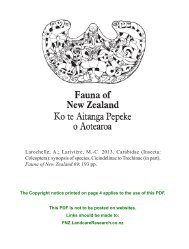Fauna of NZ 45 - Landcare Research
Fauna of NZ 45 - Landcare Research
Fauna of NZ 45 - Landcare Research
Create successful ePaper yourself
Turn your PDF publications into a flip-book with our unique Google optimized e-Paper software.
24 Kuschel (2003): Nemonychidae, Belidae, Brentidae (Insecta: Coleoptera)<br />
Rhicnobelus gen. nov.<br />
Fig. 4, 5, 70–83<br />
Type-species: Pachyura metallica Pascoe<br />
Because <strong>of</strong> the close relationship with Pachyurinus, only<br />
the main distinguishing characters <strong>of</strong> Rhicnobelus are here<br />
given. Prothorax converging in gentle arc to an indistinct<br />
apical constriction, with a fine groove on midline, lacking<br />
impressions. Scutellum proclinate. Elytra with metallic<br />
sheen, with transverse rugae at least near suture and no<br />
depressions. Male tibiae mucronate. The vein A 1 is complete<br />
in R. aenescens, interrupted in R. rubicundus, and<br />
absent in R. metallicus. The inferolateral flange <strong>of</strong> elytra is<br />
present in R. aenescens and R. rubicundus, absent in R.<br />
metallicus.<br />
Distribution. Endemic: North Island, South Island.<br />
Host plant. Adults and larvae found so far associated only<br />
with genera <strong>of</strong> Podocarpaceae and Phyllocladaceae.<br />
Etymology. Rhicnóbelus (‘wrinkled dart’) from the Greek<br />
rhiknós meaning wrinkled, and the weevil genus Belus<br />
(meaning bullet or dart); gender masculine.<br />
Key to species <strong>of</strong> Rhicnobelus<br />
1 Club 5-segmented, by antennae having segment 7<br />
distinctly wider than 6 and vestiture similar to that <strong>of</strong><br />
segment 8. Elytral rugae weak, usually confined to near<br />
suture. Legs bright reddish brown contrastingly paler<br />
than body. Length 4.5–6.5 mm. Northland to<br />
Marlborough and Nelson ........ (p. 24) ... rubicundus<br />
—Club 4-segmented, by antennae having segment 7 similar<br />
to 6 in width and vestiture. Elytral rugae conspicuous,<br />
extending to the sides. Legs as dark as remainder <strong>of</strong><br />
body ........................................................................ 2<br />
2(1) Metasternal sides with large patch <strong>of</strong> dense, strikingly<br />
white vestiture. Designs on elytra, when present,<br />
directed obliquely forward from suture to sides, those<br />
on middle <strong>of</strong> dorsum a V-shaped band. Length 4.5–7.5<br />
mm. From Northland to Southland ..........................<br />
.................................................. (p. 25) ... metallicus<br />
—Metasternal sides lacking patch <strong>of</strong> dense white vestiture.<br />
Designs on elytra, when present, directed obliquely<br />
backward from suture to sides, those on middle <strong>of</strong><br />
dorsum jointly an inverted V-shaped band. Length 6.5–<br />
8.9 mm. From Gisborne and Wanganui to Central Otago<br />
and Dunedin .............................. (p. 26) ... aenescens<br />
Rhicnobelus rubicundus (Broun) comb. nov.<br />
Fig. 65–69; Map 6<br />
Broun, 1880: 469 (Pachyura). —Waterhouse, 1883: 2, pl.<br />
138, fig. 2 (Pachyura). —May, 1987: <strong>45</strong> (host plant);<br />
1993: 39, fig. 208–218 (larva).<br />
pilosus Broun, 1909: 137 (as var. <strong>of</strong> Pachyura rubicunda)<br />
syn. nov<br />
violaceus Broun, 1909: 137 (Pachyura). —Hudson, 1934:<br />
147 (Pachyura) syn. nov.<br />
Black or nearly so, with coppery, brassy or bluish, sometimes<br />
iridescent sheen; antennae, legs and <strong>of</strong>ten tip <strong>of</strong> rostrum<br />
bright reddish brown; apex <strong>of</strong> antennal segments and<br />
last two tarsal segments usually darkened. Vestiture recumbent,<br />
white throughout or in part, rather long, mostly<br />
piliform, thicker, subsquamiform when condensed to dots<br />
or oblique lines on dorsum, directed straight backwards.<br />
Head conspicuously converging towards constriction,<br />
densely punctate. Frons flat, lacking fovea. Prorostrum<br />
less than twice as long as wide.<br />
Prothorax 1.22–1.32x wider than long, converging in<br />
gentle curve to indistinct collar, with an impression at base<br />
followed by a fine sulcus; punctation dense, coarse, similar<br />
to that <strong>of</strong> head, more or less aligned into transverse rows.<br />
Scutellum in lateral view not or hardly higher than<br />
pronotum, flat, transverse.<br />
Elytra in lateral view slightly ascending for a short<br />
distance behind base, parallel or slightly wider postmedially,<br />
lacking depressions, evenly convex transversely on dorsum,<br />
broadly rounded at apex; margin at apex distinctly asperate;<br />
punctation dense, coarse, somewhat aligned transversely.<br />
Wing venation as for P. sticticus (Fig. 49), A interrupted.<br />
1<br />
Femora very slender, showing hardly any swelling;<br />
middle tibiae in male mucronate, finely denticulate near<br />
mucro, slightly incurved; tarsi not obviously different in<br />
the sexes. Ventrites 1–4 with bare patch on either side.<br />
Tergites heavily pigmented, usually metallic blue.<br />
Male: Tergite 8 as in Fig. 68, heavily pigmented,<br />
separated by narrow membrane; sternite 8 as in Fig. 69,<br />
shallowly emarginate. Tegmen and aedeagus largely in<br />
agreement with P. sticticus (Fig. 61–63).<br />
Female: Sternite 8 as in Fig. 65. Genitalia as in Fig. 66;<br />
spermatheca as in Fig. 67.<br />
Length: 4.5–6.7 mm.<br />
Types. Pachyura rubicunda: described from 5 specimens<br />
from Whangarei Heads. Lectotype % (here designated,<br />
so as to assure correct and consistent application <strong>of</strong><br />
the name in the future), 6.1 x 2.0 mm, Manaia, Whangarei<br />
Heads, 831, <strong>NZ</strong>AC. Paralectotypes BMNH, <strong>NZ</strong>AC.<br />
Pachyura pilosa: described from one specimen. Holotype<br />
&, 6.7 x 2.4 mm, Helensville, var. 831 [=rubicunda],<br />
P.villosa [sic], T Broun, <strong>NZ</strong>AC.
















